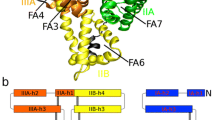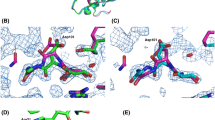Abstract
Equilibrium unfolding by guanidinium hydrochloride (GuHCl) and urea as well as evolutionary trends of two homologous albumins, pig serum albumin (PSA) and rabbit serum albumin (RSA), has been studied with circular dichroism, tryptophanyl fluorescence and bioinformatics. GuHCl cannot distinguish the contribution of electrostatic interactions to the proteins which were otherwise effectively monitored by urea. Higher differences in free energy changes due to urea than GuHCl show electrostatic interactions among charged amino acids are possibly responsible for higher structural stability of RSA in comparison to PSA. From the sequence of HSA and RSA, deletion of arginine at position 117 and the presence of one extra tryptophan at position 135 may possess some clue for lesser stability of PSA. Here, for comparison, chemical unfolding data of HSA and BSA had been taken into consideration. We found that thermodynamically RSA and PSA are closer to HSA and BSA, respectively, in accordance with their sequence homologies. Taxonomically, rabbit belongs to lagomorph which is closer to hominids than ungulates. Hence, on the basis of these thermodynamic data of protein denaturation of different species we can use this new approach to analyze the phylogenetic relationship among the major clades of eutherian mammals to obtain their evolutionary trends.




Similar content being viewed by others
Abbreviations
- BSA:
-
Bovine serum albumin
- CD:
-
Circular dichroism
- ΔC hydp :
-
Net heat capacity change of hydration
- GuHCl:
-
Guanidinium hydrochloride
- \( \Updelta G_{\text{u}}^{\text{w}} \) :
-
Change in unfolding free energy in the absence of denaturant
- HSA:
-
Human serum albumin
- MRE:
-
Mean residue ellipticity
- PSA:
-
Porcine serum albumin
- RSA:
-
Rabbit serum albumin
References
Peters, T., Jr. (1996). All about albumin: Biochemistry, genetics, and medical applications. California: Academic Press.
Dockal, M., Carter, D. C., & Ruker, F. (2000). Five recombinant fragments of human serum albumin-tools for the characterization of the warfarin binding site. J Biol Chem, 275, 3042–3050.
Muzammil, S., Kumar, Y., & Tayyab, S. (2000). Anion-induced stabilization of human serum albumin prevents the formation of intermediate during urea denaturation. Proteins, 40, 29–38.
Khan, M. Y., Agarwal, S. K., & Hangloo, S. (1987). Urea-induced structural transformations in bovine serum albumin. Journal of Biochemistry, 102, 313–317.
Halim, A. A. A., Kadir, H. A., & Tayyab, S. (2008). Bromophenol blue binding as a probe to study urea and guanidine hydrochloride denaturation of bovine serum albumin. Journal of Biochemistry, 144, 33–38.
Kosa, T., Maruyama, T., Sakai, N., Yonemura, N., Yahara, S., & Otagiri, M. (1998). Species differences of serum albumins: III. Analysis of structural characteristics and ligand binding properties during N-B transitions. Pharmaceutical Research, 15, 592–598.
Sen, P., Fatima, S., Khan, J. M., & Khan, R. H. (2009). How methyl cyanide induces aggregation in all-alpha proteins: A case study in four albumins. International Journal of Biological Macromolecules, 44, 163–169.
Gull, N., Sen, P., Khan, R. H., & Kabir-Ud-Din, (2009). Interaction of Bovine (BSA), Rabbit (RSA), and Porcine (PSA) serum albumins with cationic single-chain/gemini surfactants: A comparative study. Langmuir, 25, 11686–11691.
Ahmad, E., Naeem, A., Javed, S., Yadav, S., & Khan, R. H. (2007). The minimal structural requirement of concanavalin A that retains its functional aspects. Journal of Biochemistry, 142, 307–315.
Mizuguchi, M., Masaki, K., Demura, M., & Nitta, K. (2000). Local and long-range interactions in the molten globule state: A study of chimeric proteins of bovine and human alpha-lactalbumin. Journal of Molecular Biology, 298, 985–995.
Tayyab, S., Ahmad, B., Kumar, Y., & Khan, M. M. (2002). Salt-induced refolding in different domains of partially folded bovine serum albumin. International Journal of Biological Macromolecules, 30, 17–22.
Caballero-Herrera, A., Nordstrand, K., Berndt, K. D., & Nilsson, L. (2005). Effect of urea on peptide conformation in water: Molecular dynamics and experimental characterization. Biophysical Journal, 89, 842–857.
Caetano, W., Amaral, C. L., & Itri, R. (2006). The influence of urea on the structure of proteins in reversed micelles. J Nanosci Nanotechnol, 6, 2416–2424.
Tayyab, S., Sharma, N., & Khan, M. M. (2000). Use of domain specific ligands to study urea-induced unfolding of bovine serum albumin. Biochemical and Biophysical Research Communications, 277, 83–88.
Gill, S. C., & von Hippel, P. H. (1989). Calculation of protein extinction coefficients from amino acid sequence data. Analytical Biochemistry, 182, 319–326.
Ahmad, E., Rahman, S. K., Khan, J. M., Varshney, A., & Khan, R. H. (2010). Phytolacca americana lectin (Pa-2; pokeweed mitogen): an intrinsically unordered protein and its conversion to partial order at low pH. Bioscience Reports, 30, 125–134.
Kelley, L. A., & Sternberg, M. J. E. (2009). Protein structure prediction on the web: A case study using the Phyre server. Nature Protocols, 4, 363–371.
Bhattacharya, A. A., Curry, S., & Franks, N. P. (2000). Binding of the general anesthetics propofol and halothane to human serum albumin. High resolution crystal structures. Journal of Biological Chemistry, 275, 38731–38738.
Jo, S., Vargyas, M., Vasko-Szedlar, J., Roux, B., & Im, W. (2008). PBEQ-Solver for online visualization of electrostatic potential of biomolecules. Nucleic Acids Research, 36, W270–W275.
Miteva, M. A., Tufféry, P., & Villoutreix, B. O. (2005). PCE: Web tools to compute protein continuum electrostatics. Nucleic Acids Research, 33, W372–W375.
Larkin, M. A., Blackshields, G., Brown, N. P., Chenna, R., McGettigan, P. A., McWilliam, H., et al. (2007). Clustal W and Clustal X version 2.0. Bioinformatics, 23, 2947–2948.
Page, R. D. M. (1996). TREEVIEW: An application to display phylogenetic trees on personal computers. Computer Applications in the Biosciences, 12, 357–358.
Cheng, J., Randall, A., & Baldi, P. (2005). Prediction of protein stability changes for single-site mutations using support vector machines. Proteins, 62, 1125–1132.
Parthiban, V., Gromiha, M. M., & Schomburg, D. (2006). CUPSAT: Prediction of protein stability upon point mutations. Nucleic Acids Research, 34, W239–W242.
Soulages, J. L. (1998). Chemical denaturation: potential impact of undetected intermediates in the free energy of unfolding and m-values obtained from a two-state assumption. Biophysical Journal, 75, 484–492.
Carter, D. C., & Ho, J. X. (1994). Structure of serum albumin. Advances in Protein Chemistry, 45, 153–203.
Muzammil, S., Kumar, Y., & Tayyab, S. (1999). Molten globule-like state of human serum albumin at low pH. European Journal of Biochemistry, 266, 26–32.
Chaudhuri, T. K., Arai, M., Terada, T. P., Ikura, T., & Kuwajima, K. (2000). Equilibrium and kinetic studies on folding of the authentic and recombinant forms of human alpha-lactalbumin by circular dichroism spectroscopy. Biochemistry, 39, 15643–15651.
Im, W., Beglov, D., & Roux, B. (1998). Continuum solvation model: computation of electrostatic forces from numerical solutions to the Poisson–Boltzmann equation. Computer Physics Communications, 111, 59–75.
Ahmad, F., & Salahuddin, A. (1976). Reversible unfolding of the major fraction of ovalbumin by guanidine hydrochloride. Biochemistry, 15, 5168–5175.
Farruggia, B., & Pico, G. A. (1999). Thermodynamic features of the chemical and thermal denaturations of human serum albumin. International Journal of Biological Macromolecules, 26, 317–323.
Alur, R. P., Vijayasarathy, C., Brown, J. D., Mehtani, M., Onojafe, I. F., Sergeev, Y. V., et al. (2010). Papillorenal syndrome-causing missense mutations in PAX2/Pax2 result in hypomorphic alleles in mouse and human. PLoS Genet, 6, e1000870.
Furukawa, Y., Fu, R., Deng, H. X., Siddique, T., & O’Halloran, T. V. (2006). Disulfide cross-linked protein represents a significant fraction of ALS-associated Cu, Zn-superoxide dismutase aggregates in spinal cords of model mice. Proceedings of the National Academy of Sciences of the United States of America, 103, 7148–7153.
Tamura, H., Schild, L., Enomoto, N., Matsui, N., Marumo, F., & Rossier, B. C. (1996). Liddle disease caused by a missense mutation of beta subunit of the epithelial sodium channel gene. Journal of Clinical Investigation, 97, 1780–1784.
Liu, L., Doné, S. C., Khoshnoodi, J., Bertorello, A., Wartiovaara, J., Berggren, P. O., et al. (2001). Defective nephrin trafficking caused by missense mutations in the NPHS1 gene: Insight into the mechanisms of congenital nephrotic syndrome. Human Molecular Genetics, 10, 2637–2644.
Wilkie, S. E., Vaclavik, V., Wu, H., Bujakowska, K., Chakarova, C. F., Bhattacharya, S. S., et al. (2008). Disease mechanism for retinitis pigmentosa (RP11) caused by missense mutations in the splicing factor gene PRPF31. Molecular Vision, 14, 683–690.
Gull, N., Sen, P., & Kabir-Ud-Din, Khan. R. H. (2007). Effect of physiological concentration of urea on the conformation of human serum albumin. Journal of Biochemistry, 141, 261–268.
Levy, M. (1958). Titration of bovine serum albumin in urea and in formaldehyde solutions. Comptes Rendus des Travaux du Laboratoire Carlsberg, 30, 301–308.
Leggio, C., Galantini, L., Konarev, P. V., & Pavel, N. V. (2009). Urea-induced denaturation process on defatted human serum albumin and in the presence of palmitic acid. Journal of Physical Chemistry B, 113, 12590–12602.
Timasheff, S. (1992). Water as ligand: preferential binding and exclusion of denaturants in protein unfolding. Biochemistry, 31, 9857–9864.
Myers, J. K., Pace, C. N., & Scholtz, J. (1995). Denaturant m values and heat capacity changes: Relation to changes in accessible surface areas of protein unfolding. Protein Science, 4, 2138–2148.
Stumpe, M. C., & Grubmuller, H. (2009). Urea impedes the hydrophobic collapse of partially unfolded proteins. Biophysical Journal, 96, 3744–3752.
Akhtar, M. S., Ahmad, A., & Bhakuni, V. (2002). Divalent cation induced changes in structural properties of the dimeric enzyme glucose oxidase: Dual effect of dimer stabilization and dissociation with loss of cooperative interactions in enzyme monomer. Biochemistry, 41, 3819–3827.
Robinson, D. R., & Jencks, W. P. (1965). The effect of compounds of the urea-guanidinium class on the activity coefficient of acetyltetraglycine ethyl ester and related compounds. Journal of the American Chemical Society, 87, 2462–2470.
Pace, C. N. (1986). Determination and analysis of urea and guanidine hydrochloride denaturation curves. Methods in Enzymology, 131, 266–280.
Mayo, S. L., & Baldwin, R. L. (1993). Guanidinium chloride induction of partial unfolding in amide proton exchange in RNase A. Science, 262, 873–876.
Monera, O. D., Kay, C. M., & Hodges, R. S. (1994). Protein denaturation with guanidine hydrochloride or urea provides a different estimate of stability depending on the contributions of electrostatic interactions. Protein Science, 3, 1984–1991.
O’Brien, E. P., Dima, R. I., Brooks, B., & Thirumalai, D. (2007). Interactions between hydrophobic and ionic solutes in aqueous guanidinium chloride and urea solutions: Lessons for protein denaturation mechanism. Journal of the American Chemical Society, 129, 7346–7353.
Fulton, K. F., Jackson, S. E., & Buckle, A. M. (2003). Energetic and structural analysis of the role of tryptophan 59 in FKBP12. Biochemistry, 42, 2364–2372.
Strub, C., Alies, C., Lougarre, A., Ladurantie, C., Czaplicki, J., & Fournier, D. (2004). Mutation of exposed hydrophobic amino acids to arginine to increase protein stability. BMC Biochemistry, 5, 9.
Jandu, S. K., Ray, S., Brooks, L., & Leatherbarrow, R. J. (1990). Role of arginine 67 in the stabilization of chymotrypsin inhibitor 2: Examination of amide proton exchange rates and denaturation thermodynamics of an engineered protein. Biochemistry, 29, 6264–6269.
Trovato, R., Mulloy, J. C., Johnson, J. M., Takemoto, S., de Oliveira, M. P., & Franchini, G. (1999). A lysine-to-arginine change found in natural alleles of the human T-cell lymphotropic/leukemia virus type 1 p12(I) protein greatly influences its stability. Journal of Virology, 73, 6460–6467.
Vogt, G., Woell, S., & Argos, P. (1997). Protein thermal stability, hydrogen bonds, and ion pairs. Journal of Molecular Biology, 269, 631–643.
Acknowledgments
E. Ahmad and P. Sen thank Council of Scientific and Industrial Research, and Department of Biotechnology, Govt. of India for financial assistance in the form of SRF.
Author information
Authors and Affiliations
Corresponding author
Additional information
Ejaz Ahmad and Priyankar Sen contributed equally to this study.
Rights and permissions
About this article
Cite this article
Ahmad, E., Sen, P. & Khan, R.H. Structural Stability as a Probe for Molecular Evolution of Homologous Albumins Studied by Spectroscopy and Bioinformatics. Cell Biochem Biophys 61, 313–325 (2011). https://doi.org/10.1007/s12013-011-9214-4
Published:
Issue Date:
DOI: https://doi.org/10.1007/s12013-011-9214-4




